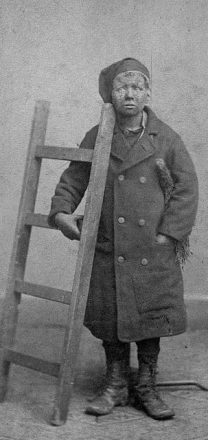
Histories of Victorian Britain are filled with tragic stories of young chimney sweeps. Recruited at age four or five and apprenticed to so-called ‘master sweeps’, these young boys endured long hours, horrendous treatment and atrocious working conditions.
Chimney sweeps usually worked in the pre-dawn hours, after flues had cooled and before morning fires were lit. With hands and knees they were forced to shimmy up dark narrow flue spaces, packed thick with soot and debris. Regular inhalation of this soot caused many young sweeps to contract respiratory illnesses, such as tuberculosis.
Some young sweeps also acquired an aggressive form of testicular cancer, colloquially known as “soot wart” or “sooty balls”. Thomas Clarke, a Nottingham master sweep, told an 1863 inquiry:
“I have known eight or nine sweeps lose their lives by the sooty cancer. The private parts which it seizes are entirely eaten off, caused entirely by ‘sleeping black’ and breathing the soot in all night.”
Workplace accidents posed a more immediate danger for chimney sweeps. The English press of the late 18th and 19th century contained dozens of reports of the deaths of these ‘climbing boys’. Some fell from roofs or down chimney structures; others become lodged in flues and suffocated; a few were roasted alive after being forced up still-hot chimneys.
One of the more tragic incidents occurred in Lothbury, near the Bank of England, where two young sweeps were sent into a baker’s chimney, one from each end:
“The [first] boy reported that the chimney contained a great deal of rubbish… not answering his master’s call, suspicion arose that he was either sulky or in a dangerous predicament. A stone in the cellar was accordingly taken up and the boy [was] found dead. The master called to the [second] boy who answered him by saying that he was so jammed in that if immediate relief was not given he should die, and this unfortunately was the case… The whole of this happened in ten minutes… Both the lads were very young and small, the oldest not more than eight years.”
Source: The Gentleman’s Magazine, vol. 95, 1804. Content on this page is © Alpha History 2019-23. Content may not be republished without our express permission. For more information please refer to our Terms of Use or contact Alpha History.
